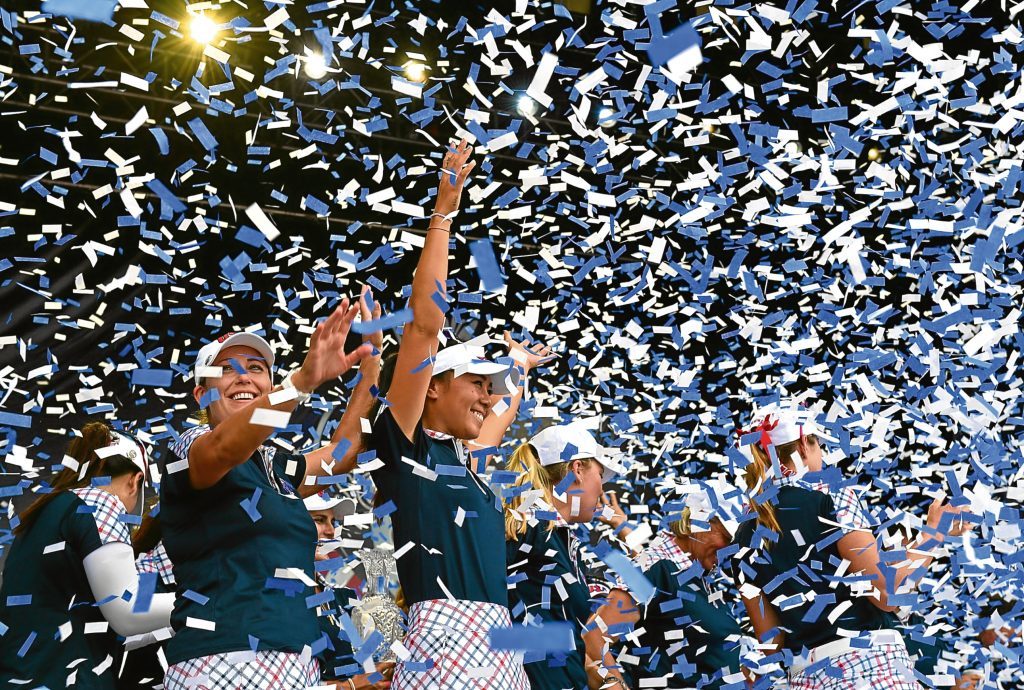So the handover took place, notably to a couple of 13-year-old young girl golfers from a group brought out to Iowa by VisitScotland rather than a fat man in a suit, and Scotland and Gleneagles is now the Solheim Cup host.
And what do we do now?
Just what we did for the Ryder Cup at Gleneagles in 2014, surely? That was logistically, profitably and in terms of global impact the most successful Ryder Cup in history, right?
Well, no, we can’t. And the hosting of the Solheim Cup in 2019 is not only a trickier proposition for Scotland but also hugely significant in terms of future investment in promotion and development of the game in this country.
Paul Bush, the director of events for VisitScotland and one of the key men behind the hugely increased government involvement in golf thinks it’s even more important than the Ryder Cup.
“The Solheim Cup has greater capacity than the Ryder Cup to make change,” he says. “There’s much more opportunity, growing the percentage (of women players in Scotland) from 15 per cent.”
But it goes further than that. There’s been a perception – one I share – that Scotland has so many top golf events now we’re about at saturation point. The government agencies are conscious of this as well.
“We are my far and away the most proactive, successful golf nation in Europe in terms of events, but there is no given that will remain,” added Bush.
“My concern looking forward is we’ve got to get to a position where people still consider it worthwhile investing in golf events.”
Why bother? Scotland presently gets £286 million a year revenue from golf. The policy of getting the Scottish Open on US TV screens has been a huge success. The amount of people in the US who are desperate to tell you how great they or their friends and families’ Scottish golf trip was is actually startling.
The eventual target of annual revenue is £300 million, and the Solheim should be the catalyst to push to that. Only it’s not just a question of putting it on and waving people through the doors.
The Ryder Cup basically sold itself; it’s one of the top five sporting events in the world. With particpation levels as they are in this country, the perceptions of women’s golf as they regrettably are, there’s no guarantee we’re going to get that similar backdrop of galleries five deep of fans along the ropes for the opening tee shots of a Solheim.
It has to be a different approach. The general theme for 2019 will be to push towards a more family-orientated event rather than the more corporate slanted theme of 2014, as financially lucrative as that was.
Family tickets will be a big thing. It’s going to be easier to come to Gleneagles for the Solheim than it was for the Ryder Cup, less park and ride from miles away, more onsite parking, much more on the trains.
But none of this is guaranteed to get people through the gates.
“We have to try and make the Solheim Cup a bucket list event,” continues Bush.
“In 2012 everyone wanted to go to the Commonwealth Games. Many didn’t know what it was. But they felt, we’ve got to go.
“I think there was some of that with the Ryder Cup as well. There’s none of it yet with the Solheim.
“We have to find a way of how do get men in particular to come and watch a Solheim Cup at Gleneagles, to make them understand what a unique event it is. We’re going to have to sell it hard and be innovative.”
A local presence
A key element to promoting a Solheim Cup in Scotland, of course, would be a native presence to rally around.
Having ruled herself out of playing again unequivocally on Sunday night, and Annika Sorenstam clarifying that hers was a once-only tenure, Catriona Matthew is surely a certainty to be captain. She wants the job and would be the most qualified candidate even if it wasn’t in Scotland.
A playing presence is far more tricky. It would require a significant career charge from any of the current crop of Scottish women professionals, none of whom are even on the LPGA.
If enthusiasm is a measurement, the six #Project19 girls who were brought to Iowa have every chance of being on the Junior Solheim Cup team
Hannah Darling and Crail’s Anna McKay have made some impact already even in senior golf. They’ve all seen this week what they have to aim at.
Securing the LET
There’s no Solheim without a Ladies European Tour, of course, and despite no official word it seems a package to secure its future is being finalised.
A week before the Solheim, the LET quietly announced the departure of chief executive Ivan Khodabakhsh, who had been a notable absentee from both Scottish and British Open weeks.
Interestingly, the rescue package would appear to involve both the LPGA and the men’s European Tour. Mike Whan and Keith Pelley have had talks already.
This properly reflects what we said in T2G last month; the LET’s survival is vital for ALL of golf, not just the women’s game.
